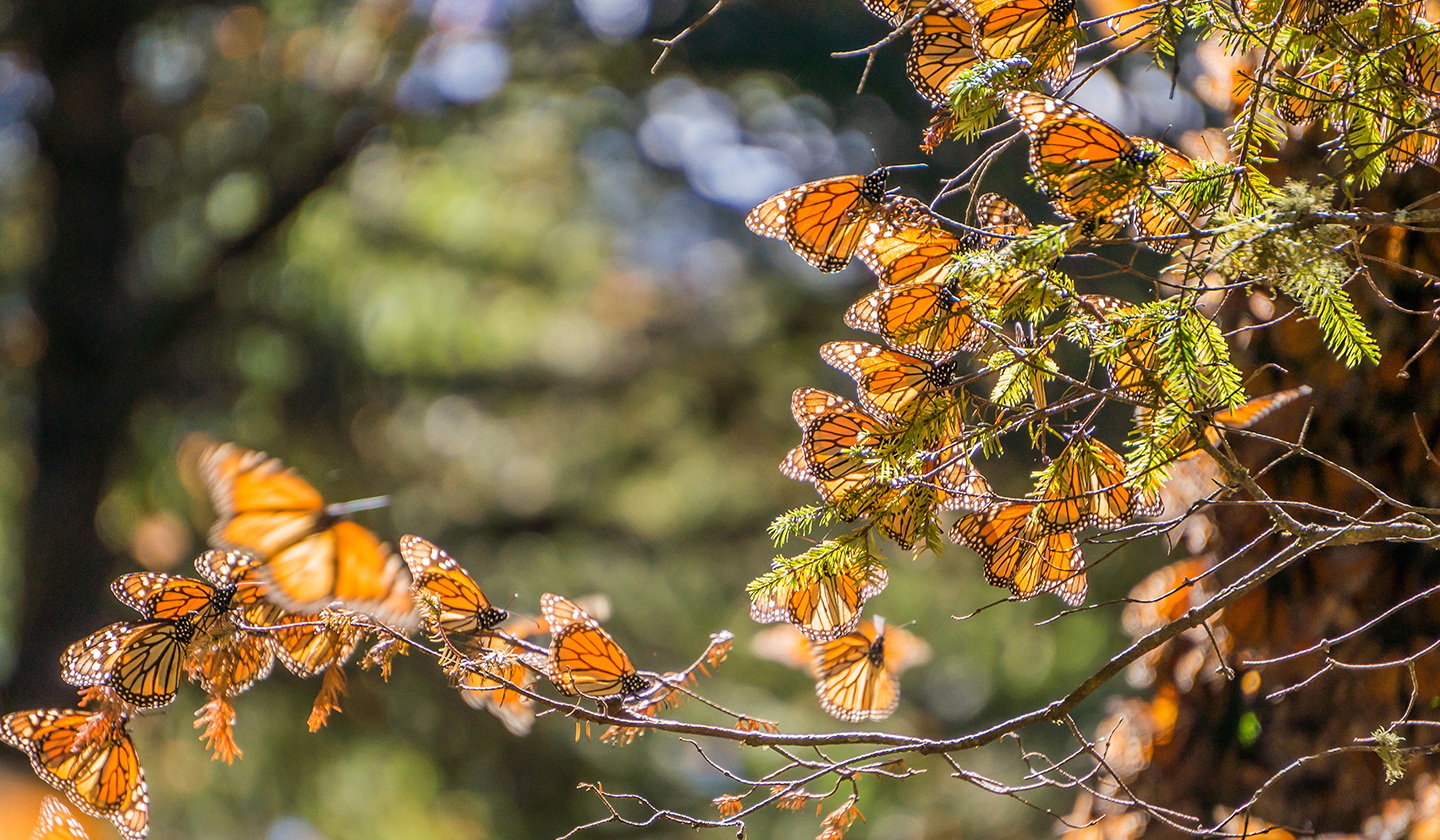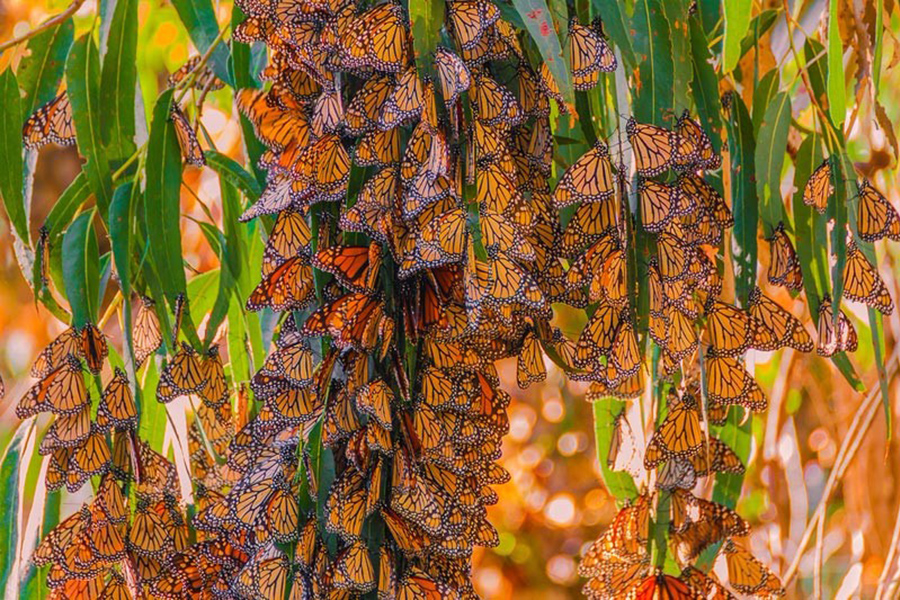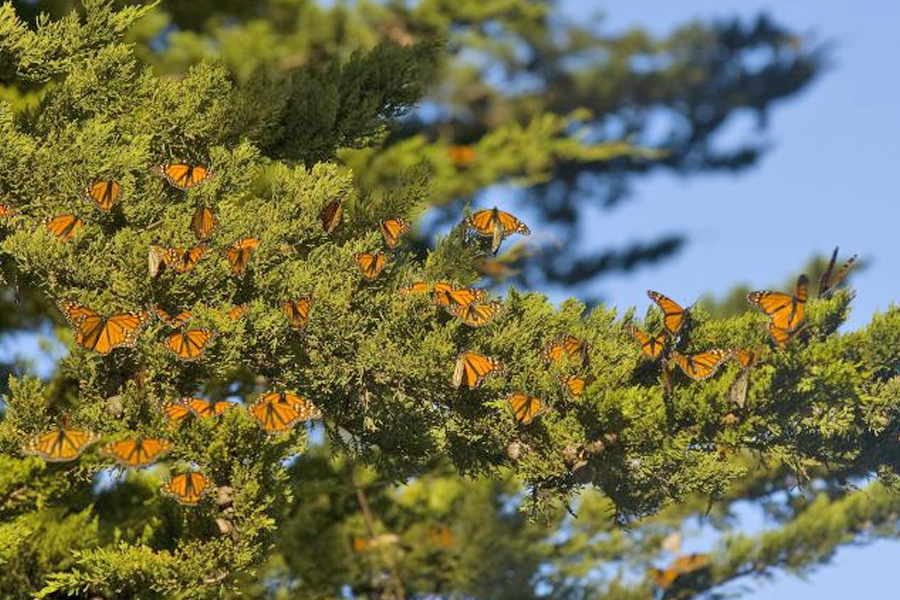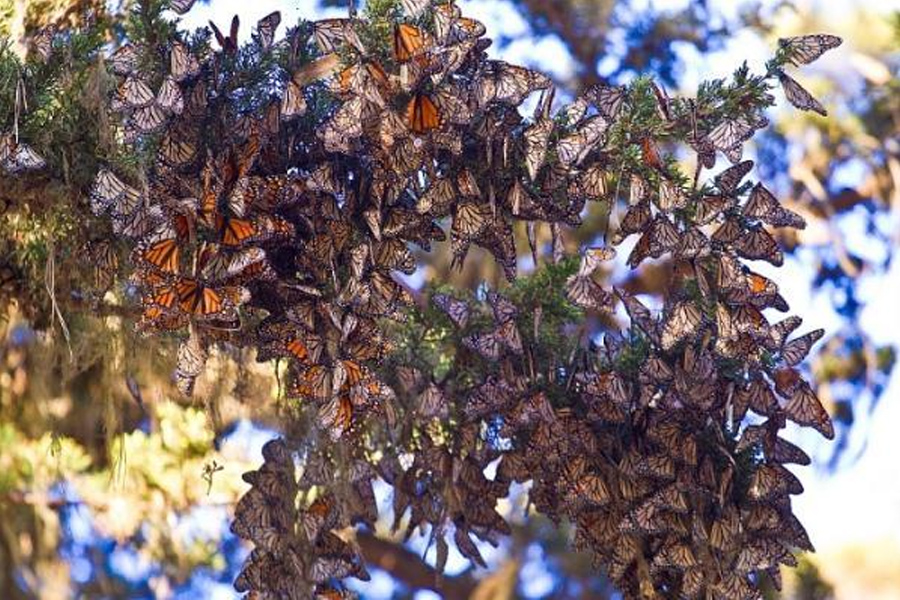Annual Monarch Butterfly Migration
Where to See Them in California
Experiencing Monarch Butterflies in person is unlike anything you’ve ever seen. They’re easily recognized with bright colors of orange, black and white in a distinctive pattern across their wings. Each year, from October through early March, these lovely butterflies migrate to central and southern California, mostly coming in from areas west of the Rocky Mountains, and south from Oregon & Idaho. They flock to San Diego, Orange County, Monterey and Santa Cruz, forming huge clusters in groves along the coast.
Here for only a few months, there’s no time like the present for a visit. Check out the sanctuary websites listed below for population levels, grab your camera and check out the monarchs while they’re here!

The Monarch Butterfly (Danaus plexippus) is a milkweed butterfly (subfamily Danainae) in the family Nymphalidae. It is a well-recognized butterfly that ranges as far north as Canada, and is considered an iconic pollinator species. As a cold-blooded creature and unable to withstand freezing winter temperatures, monarchs migrate to safe overwintering sites that are warm enough for survival and cool enough to conserve precious energy.
Most Monarchs west of the Rocky Mountains migrate to locations on the central California coast. Monarchs east of the Rockies spend their winters in the high mountains of central Mexico. En route, they may travel as far as 3,000 miles, covering up to one hundred miles per day, and flying as high as 10,000 feet.
What makes the monarch migration so unique? In many migrating species, generally the same individuals travel the migration route year after year. In contrast, migrating monarchs have never been to their destination before. In fact, as many as 3-4 generations of monarchs may have lived and died since last year’s butterflies departed.

Monarchs can travel as much as 50-100 miles a day, taking up to two months to reach their final destination. The longest distance on record for one day’s travel is an incredible 265 miles! SOURCE: USDA & US Forest Service
Overwintering
With the approach of fall, a special generation of monarchs is born. These monarchs live much longer, up to eight months. Triggered by the decreasing daylight and angle of the sun, these butterflies delay sexual maturity and begin flying toward their overwintering grounds, in some cases up to 2,000 miles away. They feed on flower nectar during the journey to build up the fat reserves that will enable them to survive the winter months.
Once arriving at their destination, monarchs gather in large clusters for protection from the elements. Their flight muscles do not function well in temperatures below 55 degrees, so monarchs rest quietly on the trees to conserve their strength, waiting until sunlight warms them enough to fly.
On warm days, the butterflies leave the trees to seek nectar sources with which to replenish their energy reserves, returning well before evening and its cooler temperatures to once again cluster in the trees.
The overwintering monarchs do not mate until the increasing temperatures and daylight in February trigger the development of their sexual organs. They can then be seen performing spiral mating flights, after which the coupled pair will rest overnight. The male passes a nutrient rich sperm packet to the female during mating. With newly fertilized eggs, the female will travel far in search of milkweed on which to lay them. By March, most of the butterflies have departed on their spring migration.
The Monarch Lifecycle
Female monarch butterflies lay 300-500 eggs over 2-5 weeks of egg laying. Monarch females usually lay a single egg on the underside of a milkweed leaf, near the top of the plant. As females lay their eggs, they secrete a small amount of glue to attach the eggs directly to the plant. Eggs are only about the size of a pinhead or pencil tip and are off-white or yellow, characterized by longitudinal ridges that run from the tip to the base. The eggs hatch in 4-5 days after they are laid, depending on the temperature.
The newly hatched larva feeds voraciously on the milkweed, accumulating bitter chemicals from the host plant that help protect the monarch from predation by birds. Over the next few weeks, the caterpillar grows from 1/16th of an inch to about 2 inches in length, increasing its weight by a factor of 2,700. To accommodate this rapid growth, the caterpillar must shed its distinctively striped skin several times before it is ready for the next stage of its development.
A mature caterpillar usually leaves the milkweed to seek out a bare branch or similar sturdy surface. It attaches itself by spinning a silk anchor known as the cremaster from which it hangs upside down in the shape of the letter “j”. After settling down, the caterpillar sheds its skin a final time, revealing a beautiful green chrysalis decorated with delicate gold spots.
Inside the chrysalis, the caterpillar’s body is undergoing metamorphosis, the process by which its tissues and organs rearrange into the startlingly different body of a monarch butterfly. After two weeks, the chrysalis becomes transparent, signaling that the butterfly within is ready to emerge.
The chrysalis splits open along several joints, and the monarch butterfly carefully emerges. Its wings are still folded and crumpled from confinement in the chrysalis, so the butterfly must pump fluid from its body into the wings, expanding them quickly to full size. The butterfly then rests quietly for a few hours to allow the wings to dry and harden before embarking on its maiden flight.
It takes monarchs about a month to go through all four stages, with hormones triggering the changes that occur during metamorphosis. Once adults, monarchs will live another two to six weeks in the summer. Monarchs that migrate south live all winter, generally 6-9 months.
Spring and Summer
Where to See Monarch Butterflies

Goleta Monarch Butterfly Grove
The Goleta Butterfly Grove (Ellwood Main) is in the Sperling Preserve on the Ellwood Mesa in Goleta, CA. The area and the monarch site are named after Ellwood Cooper, who settled with his family here in 1870. Cooper grew olives, walnuts, grapes, almonds, oranges, lemons and Japanese persimmons on his large ranch. This created a very favorable setting for the yearly visitation of monarchs to our area. PHOTO: Explore the Coast

Pismo Beach Monarch Butterfly Grove
Every year from late October through February thousands of orange and black Monarch butterflies migrate south to this stunning grove in Pismo Beach, California. If you are staying along the San Luis Obispo coast during these months you should stop at the North Beach Grove at Pismo State Beach to see colorful butterflies numbering in the tens of thousands that hang upside down in the Monterey Pines and Eucalyptus Trees.

Santa Cruz Monarch Butterfly Grove
The Santa Cruz Monarch Butterfly Grove is located on the western edge of town in the park at Natural Bridges State Beach. The visitor center at the park has information on the butterflies and their amazing migration. You’ll see more of them in November, but they stay here from mid-October through mid-February.

Pacific Grove Monarch Butterfly Sanctuary
Arriving in October, monarch butterflies cluster together on pine, cypress and eucalyptus trees in the Pacific Grove Sanctuary. Their migration to Pacific Grove is so unique that Pacific Grove is nicknamed “Butterfly Town, U.S.A.” The community has always welcomed the butterflies and advocated for their protection.
